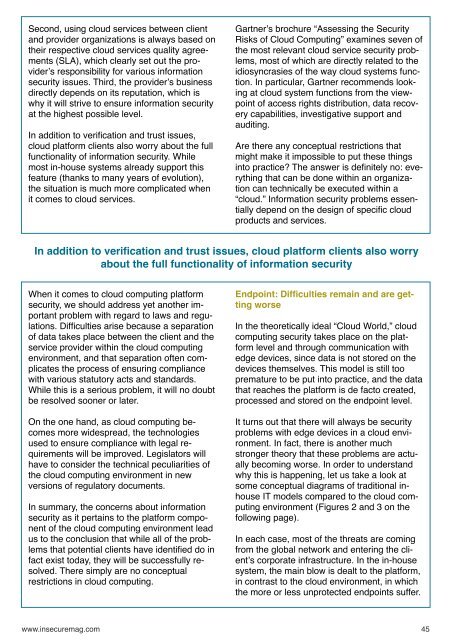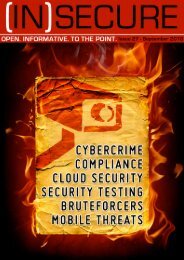You also want an ePaper? Increase the reach of your titles
YUMPU automatically turns print PDFs into web optimized ePapers that Google loves.
Second, using cloud services between client<br />
and provider organizations is always based on<br />
their respective cloud services quality agreements<br />
(SLA), which clearly set out the provider!s<br />
responsibility for various information<br />
security issues. Third, the provider!s business<br />
directly depends on its reputation, which is<br />
why it will strive to ensure information security<br />
at the highest possible level.<br />
In addition to verification and trust issues,<br />
cloud platform clients also worry about the full<br />
functionality of information security. While<br />
most in-house systems already support this<br />
feature (thanks to many years of evolution),<br />
the situation is much more complicated when<br />
it comes to cloud services.<br />
Gartner!s brochure “Assessing the <strong>Security</strong><br />
Risks of Cloud Computing” examines seven of<br />
the most relevant cloud service security problems,<br />
most of which are directly related to the<br />
idiosyncrasies of the way cloud systems function.<br />
In particular, Gartner recommends looking<br />
at cloud system functions from the viewpoint<br />
of access rights distribution, data recovery<br />
capabilities, investigative support and<br />
auditing.<br />
Are there any conceptual restrictions that<br />
might make it impossible to put these things<br />
into practice? The answer is definitely no: everything<br />
that can be done within an organization<br />
can technically be executed within a<br />
“cloud.” Information security problems essentially<br />
depend on the design of specific cloud<br />
products and services.<br />
In addition to verification and trust issues, cloud platform clients also worry<br />
about the full functionality of information security<br />
When it comes to cloud computing platform<br />
security, we should address yet another important<br />
problem with regard to laws and regulations.<br />
Difficulties arise because a separation<br />
of data takes place between the client and the<br />
service provider within the cloud computing<br />
environment, and that separation often complicates<br />
the process of ensuring compliance<br />
with various statutory acts and standards.<br />
While this is a serious problem, it will no doubt<br />
be resolved sooner or later.<br />
On the one hand, as cloud computing becomes<br />
more widespread, the technologies<br />
used to ensure compliance with legal requirements<br />
will be improved. Legislators will<br />
have to consider the technical peculiarities of<br />
the cloud computing environment in new<br />
versions of regulatory documents.<br />
In summary, the concerns about information<br />
security as it pertains to the platform component<br />
of the cloud computing environment lead<br />
us to the conclusion that while all of the problems<br />
that potential clients have identified do in<br />
fact exist today, they will be successfully resolved.<br />
There simply are no conceptual<br />
restrictions in cloud computing.<br />
Endpoint: Difficulties remain and are getting<br />
worse<br />
In the theoretically ideal “Cloud World,” cloud<br />
computing security takes place on the platform<br />
level and through communication with<br />
edge devices, since data is not stored on the<br />
devices themselves. This model is still too<br />
premature to be put into practice, and the data<br />
that reaches the platform is de facto created,<br />
processed and stored on the endpoint level.<br />
It turns out that there will always be security<br />
problems with edge devices in a cloud environment.<br />
In fact, there is another much<br />
stronger theory that these problems are actually<br />
becoming worse. In order to understand<br />
why this is happening, let us take a look at<br />
some conceptual diagrams of traditional inhouse<br />
IT models compared to the cloud computing<br />
environment (Figures 2 and 3 on the<br />
following page).<br />
In each case, most of the threats are coming<br />
from the global network and entering the client!s<br />
corporate infrastructure. In the in-house<br />
system, the main blow is dealt to the platform,<br />
in contrast to the cloud environment, in which<br />
the more or less unprotected endpoints suffer.<br />
www.insecuremag.com 45





